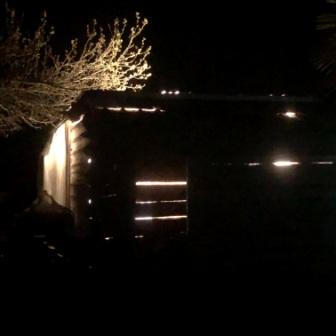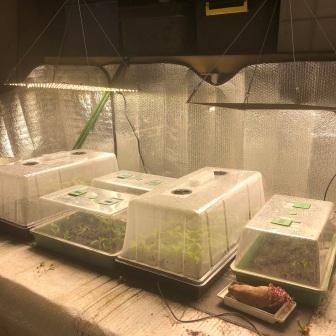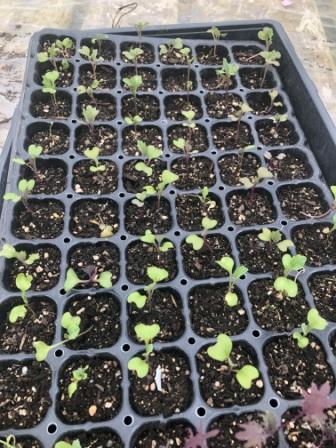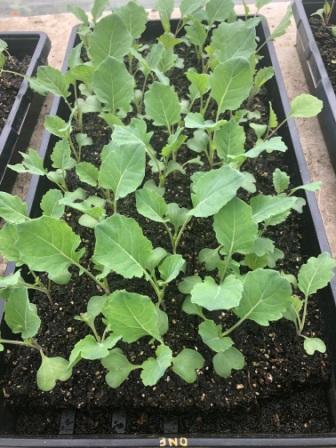 |
||||
| > Welcome > Grow and Eat > Heat Mats and Grow Lights for Vegetable Seeds
|
||||
Heat Mats and Grow Lights for Vegetable SeedsIn a little dark garden shed named The Indestructible, there is a secret. Hours after sunset, blazing light glows between the wall timbers. An open entrance is covered by heavy plastic weighted by a straight tree branch. A blanket lines the back of the plastic, to insulate the shed. Slip inside The Indestructible, and discover our secret Seedling Room. Against one wall of the shed is a rectangular kitchen table, a a trestle table against the opposite wall, a narrow pathway between the two. Each table is covered with a large flexible black plastic rectangle with an electric cord on one corner, connected to an electrical power board. Heat mats. These are heat pads on steroids, larger than a child's nursery cot, they seem HUGE after the small rectangular heat pads. Combine the heat pads with knowledge of the temperature seeds like to germinate best at, as well as a thermometer and I'm pretty sure there is a growth advantage. But wait there's more! Hanging low over each table by chains are two metal plates about 45cm x30cm. Gorgeous bright light shines from the underside of each metal plate. Ah, now we see the source of the light glimpsed from outside, a light also welcome on dreary late winter and early spring days. Grow Lights. These Grow Lights are the only variety I have tried, but they seem to do work well. Once germinated the seedlings grow strong and quickly under the lights. Let's do a little experiment to see if there is an advantage to the heat mat and grow light set up: 1. Brassica Seeds (broccoli varieties, cauliflowers, kohlrabi) are germinated in mini blocks on a heat mat (no grow light). 2. Once germinated, and seedlings are growing their first set of true leaves, most seedlinbgs are transplanted into fresh soil blocks (more about blocks in another post) and placed under grow lights in the Seedling Room. 3. Other seedlings are transplanted into a module tray using saved block mix from last year, and stay on the outdoor seedling table, covered only on rough windy and/or colder weather (7 degrees celsius and lower). Can you see the difference in the seedlings? This is pretty good evidence to me that heat mats, grow lights, soil blocks and soil mix do give seedlings a growth advantage.
But WHY, you may ask, do I want to use heat mats and grow lights? Apart from the usual reasons - large garden, do not buy veg from shops or supermarkets, gift vegetables to others - we have a tricky microclimate. The first spring here in this location, we struggled to germinate any seeds at all, let alone keep the seedlings alive until the soil was warm enough to transplant into. Keep in mind we have had 13 medium to large food gardens in 29 years, in three different countries, in all kinds of microclimates. So, I was a little baffled at this new (to me) challenge. This garden is located in a mini valley, between two verdant green hills, with farms on both sides. The cold air, mist and frost seems to pool in our little valley. So seeds would sometimes germinate but then refuse to grow outdoors or even indoors. Still not satisfied with my explanation, I researched online, let my brain roam "on the edge" even thinking maybe there is some electrical interference via the geology. I haven't come up with any good reason. Do you have any thoughts? If so let me know via the Contact page. (The emails go to a dedicated email for Vital Force NZ.) But, thanks to help from our kind and generous Father in heaven, someone gave a little gift to help develop the garden. So we were able to set up the Seedling Room. I am so very thankful. Next challenge: Keeping the seedlings alive in a garden overflowing with slimy slugs! *** Since 2021, we have started three new large food gardens in three different locations. I'm looking forward to sharing a few adventures with you. Until then, thank you as always dear ones. Praying you might learn a little something from our experiences.
Posted: Sun 22 Sep 2024 |
||||
|




 t
t